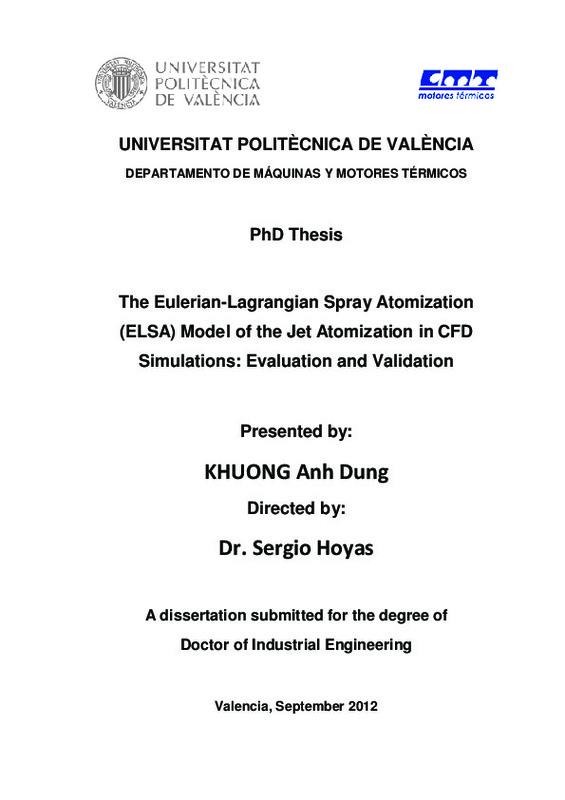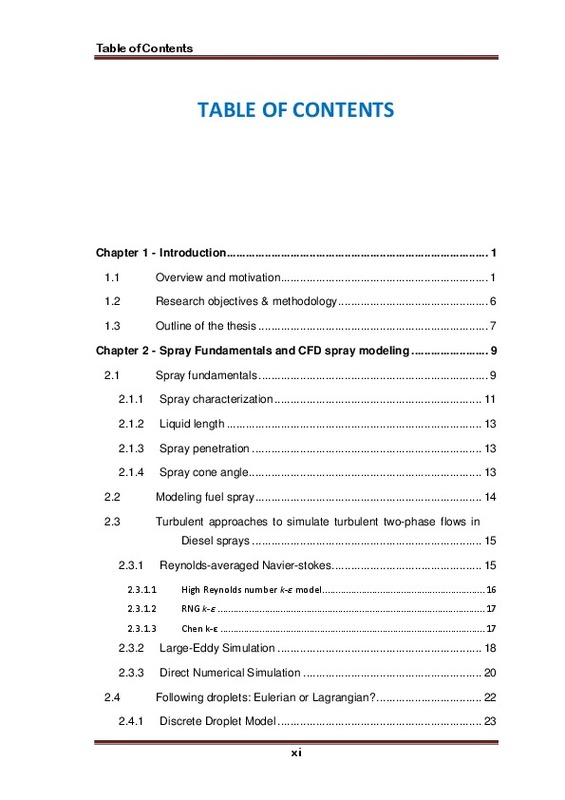- RiuNet repositorio UPV
- :
- Investigación
- :
- Tesis doctorales
- :
- Ver ítem
JavaScript is disabled for your browser. Some features of this site may not work without it.
Buscar en RiuNet
Listar
Mi cuenta
Estadísticas
Ayuda RiuNet
Admin. UPV
The Eulerian-Lagrangian Spray Atomization (ELSA) Model of the Jet Atomization in CFD Simulations: Evaluation and Validation
Mostrar el registro sencillo del ítem
Ficheros en el ítem
| dc.contributor.advisor | Hoyas Calvo, Sergio
|
es_ES |
| dc.contributor.author | Khuong ., Anh Dung
|
es_ES |
| dc.date.accessioned | 2012-09-27T06:37:54Z | |
| dc.date.available | 2012-09-27T06:37:54Z | |
| dc.date.created | 2012-09-20T08:00:00Z | es_ES |
| dc.date.issued | 2012-09-27T06:37:44Z | es_ES |
| dc.identifier.uri | http://hdl.handle.net/10251/17237 | |
| dc.description.abstract | Fuel sprays play a major role in order to achieve the required combustion characteristics and pollutant emissions reduction on internal combustion engines, and thus, an accurate prediction of its behavior is required to perform reliable engine combustion and pollutant simulations. A great effort both on experimental and theoretical studies of spray atomization and dispersion has been performed in the latest years. As a result, Computational Fluid Dynamics (CFD) calculations have become a standard tool not only for spray physics understanding but also for design and optimization of engine spray systems. However, spray modeling in its different uses in the Internal Combustion Engine (ICE) context is still nowadays a challenging task due to the complex interrelated phenomena taking place, some of them still not fully understood. Primary atomization and secondary breakup, droplet collision, coalescence and vaporization, turbulent interactions between phases have to be solved under high Reynolds (so they are turbulent) and Weber numbers conditions due to the high speed (~500 m/s) and small nozzle diameter (~100 µm) imposed by current engine injection systems technologies. Moreover, Taylor numbers cover a wide range, according to the composition of the injected liquid. Those conditions make experimental observations quite challenging and probably insufficient, especially in the very near nozzle region, where primary atomization takes place. Most of the CFD spray models are currently based on the Discrete Droplet Method. The continuous liquid jet is discretized into 'blobs' or 'parcels', which consists in a number of droplets with the same characteristics. A Lagrangian method is applied to track the liquid phase parcels, which are subject to breakup according to atomization models mainly based on the linear instability theory proposed by Reitz and later extended by Huh and Gosman for liquid turbulence effects to be considered. This approach has been successfully applied b | es_ES |
| dc.language | Inglés | es_ES |
| dc.publisher | Universitat Politècnica de València | es_ES |
| dc.rights | Reserva de todos los derechos | es_ES |
| dc.source | Riunet | es_ES |
| dc.subject | Elsa | es_ES |
| dc.subject | Diesel sprays | es_ES |
| dc.subject | Eulerian | es_ES |
| dc.subject | Lagrangian | es_ES |
| dc.subject | Computational fluid dynamics | es_ES |
| dc.subject | Cfd | es_ES |
| dc.subject | Eulerian-lagrangian spray atomization | es_ES |
| dc.subject | Atomization | es_ES |
| dc.subject | Turbulence | es_ES |
| dc.subject | Droplet | es_ES |
| dc.subject.classification | INGENIERIA AEROESPACIAL | es_ES |
| dc.title | The Eulerian-Lagrangian Spray Atomization (ELSA) Model of the Jet Atomization in CFD Simulations: Evaluation and Validation | |
| dc.type | Tesis doctoral | es_ES |
| dc.identifier.doi | 10.4995/Thesis/10251/17237 | es_ES |
| dc.rights.accessRights | Abierto | es_ES |
| dc.contributor.affiliation | Universitat Politècnica de València. Departamento de Máquinas y Motores Térmicos - Departament de Màquines i Motors Tèrmics | es_ES |
| dc.description.bibliographicCitation | Khuong ., AD. (2012). The Eulerian-Lagrangian Spray Atomization (ELSA) Model of the Jet Atomization in CFD Simulations: Evaluation and Validation [Tesis doctoral]. Universitat Politècnica de València. https://doi.org/10.4995/Thesis/10251/17237 | es_ES |
| dc.description.accrualMethod | Palancia | es_ES |
| dc.type.version | info:eu-repo/semantics/acceptedVersion | es_ES |
| dc.relation.tesis | 3918 | es_ES |
Este ítem aparece en la(s) siguiente(s) colección(ones)
-
Tesis doctorales [5389]







![Text file [Text]](/themes/UPV/images/text.png)


